The best graphics cards to buy right now
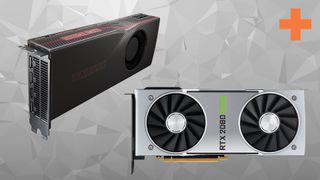
The best graphics cards for your gaming machine are not necessarily the ones that have the biggest price. Generally you do well to follow the trend like one does with wine - quality generally going upward with a larger price tag - but this is not always the case. Particularly in terms of finding the best graphics card for you. Sometimes some careful planning, distribution of your wider budget and forward thinking means that the best graphics card that anyone can get for gaming isn't the best GPU for your build or for gaming overall. For example, an RTX 2080 Ti is a wonderfully splendorous thing to have. For most of us that won't be the case and it would be very hard to justify that expense when the increase in performance isn't as eye-watering as the jump up in price tag. Luckily, with the release of the RTX Super graphics cards and AMD's RX 5000-series, prices of those cards that are only a tiny bit older have depressed quite a bit recently. We expect that trend to continue as retailers get enough stock to match demand on the new cards, while simultaneously trying to shift those that are slightly older ahead of, but also during, the peak trading season.
So where do you start shopping for the best graphics card? On the high end, the best value is currently Nvidia's RTX 2080, particularly as that card starts to see big sales with the release of the 2080 Super tomorrow. On the more affordable end of the spectrum, Nvidia's GTX 1660 and 1660 Ti cards provide a fair amount of punch for a whole lot less money, or if you're an AMD fan, an older RX 580 may suffice to see you through the current era of 1080p gaming without sacrificing much in terms of frame rate. These cards won't give you blistering performance or push 4K, but they will be good value, and mean you can spread your budget to other components and peripherals.

Nvidia GeForce GTX 2080 Super
Why you can trust GamesRadar+
Specifications
Reasons to buy
Reasons to avoid
The brand new RTX 2080 Super is now the best card on the market now in terms of peak performance and price. While it's still an expensive proposition, Nvidia isn't charging a Founder's Edition tax for this latest refresh which means it's actually less than it's predecessor (which it outperforms by 5-10%). While the step-up version, the 2080 Ti, remains more powerful, the additional dough isn't worth it for a relatively marginal increase in computing power (between 10 and 30 percent), especially considering the relatively limited use cases for ray tracing that exist at the moment. While we're seeing more ray traced games looming on the horizon, including Wolfenstein: Youngblood, the Call of Duty reboot, and Control, the current pool of games with DXR or Vulkan RT support remains relatively shallow.
The RTX 2080 Super doesn't have any flashy new tricks up its sleeve. Instead, it feels like a mid-generation refresh, obviously targeted at taking the wind out of AMD's sails around the launch of Red Team's new RX 5000-series. While it's counter-marketing success is a matter of a much debate, one fact is undeniable: the 2080 Super is the best (borderline) mainstream graphics card on the market right now, delivering excellent 4K performance (and blistering QHD) for the best price point we've seen thus far for that level of performance.

Nvidia GeForce GTX 1660
Specifications
Reasons to buy
Reasons to avoid
If you're looking for a modern, entry level graphics card that provides reasonable performance at an attractive price point, the 1660 is the choice for you. Slotting into the space vacated by the GTX 1060, and providing something like 13-15% better performance at less cost, the 1660 takes advantage of the Turing architecture implemented in the RTX lineup but paired with the widely available (and thus inexpensive) GDDDR5 VRAM.
The 1660 is clearly Nvidia's play to get into that golden market where, according to Steam Hardware Survey results, the vast majority of PC gamers shop. It's a mainstream play, perhaps aimed in part at mitigating the slower-than-expected sales of the 20-series family, but it delivers exactly what you expect at a price you can live with.
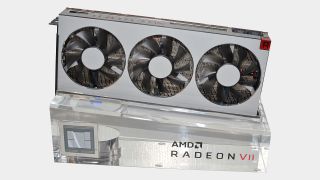
AMD Radeon VII
Specifications
Reasons to buy
Reasons to avoid
AMD finally responded to Nvidia's RTX 20-series cards earlier this year in the shape of the Radeon VII, their most powerful consumer offering aimed at demanding gamers who are AMD diehards or remain skeptical of dedicated ray tracing cores. It's a great card that delivers extremely strong 1440p and reasonable 4k Ultra performance, and the first ever GPU manufactured with 7nm lithography. It's a powerful card at a reasonable price and, if you want a top shelf AMD card or favor their HMB2 memory solution, it's really your only choice.
A good thing, then, that they've delivered a competitive card. It's roughly analogous to the RTX 2080 in terms of horsepower and retails for less, though it doesn't come with any of Nvidia's much vaunted RT or Tensor cores for ray tracing and DLSS. If those aren't features that entice, however, the Radeon VII is a great alternative to Nvidia's growing stable, which now includes less expensive Super versions of three of the RTX cards.
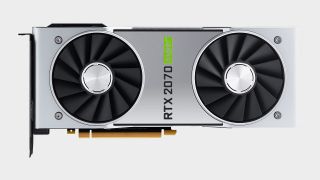
Nvidia GeForce RTX 2070 Super
Specifications
Reasons to buy
Reasons to avoid
Coming in as the mid-tier card of Nvidia's new RTX Super stack, the RTX 2070 Super is the best of the bunch in terms of sheer dollars/frames. With the vanilla 2070 (and 2080) being phased out, the new Super version will be the only 2070 part available, and it's a worthy replacement. With performance that approaches the RTX 2080 (Nvidia has opted against a Founder's Edition premium on the new Super cards), it's hard to argue with the 2070 Super as a value proposition.
This is a card that delivers incredible 1440p performance in triple-A titles, even with ray tracing enabled in the games that support it. While games with GPU intensive ray tracing techniques like Metro's global illumination may stagger a little at higher resolutions, the 2070 Super does an admirable job even at 4K in most cases. This is especially true in games that also support DLSS, which is actually a frame saving technique Nvidia developed to downsample rendered images and then using artificial intelligence (powered by the RTX's cards Tensor cores) to add the pixels back in, without putting so much strain on the card's main processing capability. The result is an excellent card at an attractive price point, and an easy recommend if you can afford it.
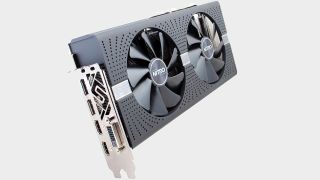
AMD Radeon RX 580 8GB
Specifications
Reasons to buy
Reasons to avoid
If you have yet to make the leap to a 4K display, spending a tremendous amount of money on an overpowered GPU may seem like an act of excessive decadence. While you’re saving cash for a new 4K monitor, AMD’s budget option can easily cope with the tail of the 1080p era.
For the budget conscious and anyone looking to ensure your PC is keeping pace with current generation consoles, the 580 is a great solution. And its 8GBs of GDDR5 is generous in comparison to Nvidia’s similarly priced 1060 line, overhead that will be greatly appreciated as rendering demands continue to escalate.
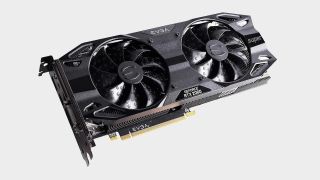
Nvidia GeForce RTX 2060 Super
Specifications
Reasons to buy
Reasons to avoid
The tip of the spear alongside the 2070 Super, the RTX 2060 Super is the cheapest way to prepare your rig for our ray tracing, DLSS enabled future. As well as packing Nvidia's much touted new features, the 2060 Super outperforms the card it's meant to replace, the vanilla 2070. It gets you everything packed into the 2070 Super's stable, just slightly less of each, but if you're looking to grab a card to handle 1080p and 1440p gaming the 2060 is the least expensive way to get onboard the ray tracing bandwagon.
If you've already got a card in the GTX 1070 range, the jump to the 2060 Super might seem premature, especially around launch when they'll be hovering near full price. But if you're looking to step up from a 970 or lower card, the 2060 Super is your best bet for great performance that will, to some extent, future proof your setup for the inevitable proliferation of DXR and Vulkan RT.

AMD Radeon RX 5700 XT
Specifications
Reasons to buy
Reasons to avoid
With a dramatic, pro-wrestling-style last second price cut just days before launch, AMD managed to slightly undercut Nvidia's new Super launch. AMD can now confidently claim their card outperforms the RTX 2060 Super but retails for the same price.
Of course, what that kind of marketing jargon leaves out is that the RX 5700 XT lacks the RTX cards' ray tracing and Tensor cores. It's thus less well suited for games that employ ray tracing or DLSS, though in terms of pure horsepower, it jumps ahead of the 2060 Super by around 5-10%. It's also very power efficient as a result of AMD's 7nm process and the shiny new RDNA architecture. The RX 5700 XT also supports AMD's Radeon Image Sharpening, which AMD claims will sharpen graphics with almost no performance impact in games that support it. While at the moment it's more gimmick than feature, if its adopted more broadly it could be a way for AMD to mitigate the lack of built-in RT and DLSS support on its parts.
Sign up to the GamesRadar+ Newsletter
Weekly digests, tales from the communities you love, and more
Alan Bradley was once a Hardware Writer for GamesRadar and PC Gamer, specialising in PC hardware. But, Alan is now a freelance journalist. He has bylines at Rolling Stone, Gamasutra, Variety, and more.
Most Popular



